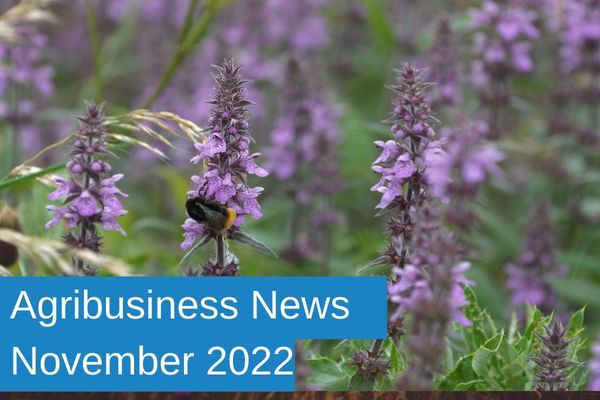Agribusiness News November 2022 – Sector Focus: Nature Conservation
1 November 2022Driven Support
Scottish Government have indicated in the months since the Glasgow COP26 conference that they want to see transformational change within the agricultural sector and at landscape scale if we are as a society to meet the challenges of climate change and nature decline.
In 2019, the State of Nature report was released, detailing how Scotland’s priority species, habitats and larger ecosystems had changed over the decades, using 1970 as a baseline. In many ways, the report was a challenging read, with findings suggesting that some 37% of species surveyed had seen declines in the last decade.
It should also be said that the same report indicates that 30% of species have seen increases and the remaining 33% showing little change. Some might be tempted to suggest the findings are unremarkable and that fluctuations over time are inevitable, however fragility in some areas can impact the whole system and it is increasingly important that, as a policy driver, farmers and crofters are engaged with the topic.
Agri-Environment Climate Scheme
To address Scotland’s nature decline, the Scottish Government have supported and continue to support the Agri-Environment Climate Scheme (AECS) as its principle environmental scheme. AECS was launched back in 2015 and over the years has provided funding support for sustainable land management practices and capital to enhance those activities.
The scheme provides farmers and crofters with a five-year contract, committing them to a set of management requirements based on chosen, voluntary options that can be allocated to a variety of different land types. In practice, this means that a business receives, often an area-based payment, on top of their basic payment, providing for many, a sense of security and continuity.
AECS is however not for the faint hearted, to ensure value for money and genuine environmental benefits each application is scored in a competitive manner, with only the highest scoring in a given year being offered a contract. This focus on high perceived nature conservation benefit means that often the most successful applications have a dynamic mix of different management and capital items.
Prospective applicants must go through a rigorous process, providing information and maps discussing habitat types and condition, management history, impacts on priority species and protected nature sites etc. culminating in a site visit with your allocated case officer and a final decision on your application.
Interested farmers, crofters and landowners can find their own eligible management and capital items options at http://targeting.ruralpayments.org/
Nature Restoration Fund
For those looking to achieve a more bespoke nature outcome, one that does not easily fit within the purview of AECS; the Nature Restoration Fund (NRF) could fit the bill.
NRF offers capital support for nature conservation outcomes that the applicant details and proposes, so different to opting into set management requirements.
The fund has two steams, Helping Nature, which supports projects between £25k – £250k and Transforming Nature, which deals with proposals with a value more than £250k. The fund has five funding priorities:
- Habitats & Species,
- Freshwater,
- Coastal & Marine,
- Invasive & Non-native species, and
- Urban environments.
Linking multiple priorities can increase the prospects of a successful application. For further information, please see online at Nature Scot.
Timelines
AECS has been confirmed for an additional two funding rounds before the end of 2024 and is expected to return in spring 2023.
The next round of NRF is expected to be in late autumn 2022.
Further Information & Advice
For more information on your environmental options, FAS has a range of support to help you decide what is right for your business including:
- the funded advice helpline, and
- specialist advice for biodiversity, habitat, and landscapes https://www.fas.scot/specialist-advice/
Alexander Pirie, Agricultural Consultant
Sign up to the FAS newsletter
Receive updates on news, events and publications from Scotland’s Farm Advisory Service

